This is the website of Abulsme Noibatno Itramne (also known as Sam Minter).
Posts here are rare these days. For current stuff, follow me on Mastodon
|
Clinton and Sanders left the Wyoming caucuses with a 7 to 7 delegate tie.
In the mean time, since Wisconsin Sanders has been winning the superdelegate race. The net change over that time has been Sanders +7, Clinton +2. This actually includes one delegate that actually did indeed switch from Clinton to Sanders (with a couple days as uncommitted in between). So far, that has been a very rare event. Perhaps it is the beginning of a trend? If so, I will of course note it here.
Adding up the changes since Wisconsin, we get Sanders +14, Clinton +9. This means Sanders has gotten an impressive 60.87% of recent delegates…
…which is not enough. Sanders needed to get better than 67.76% of the delegates to be on pace to catch up and win.
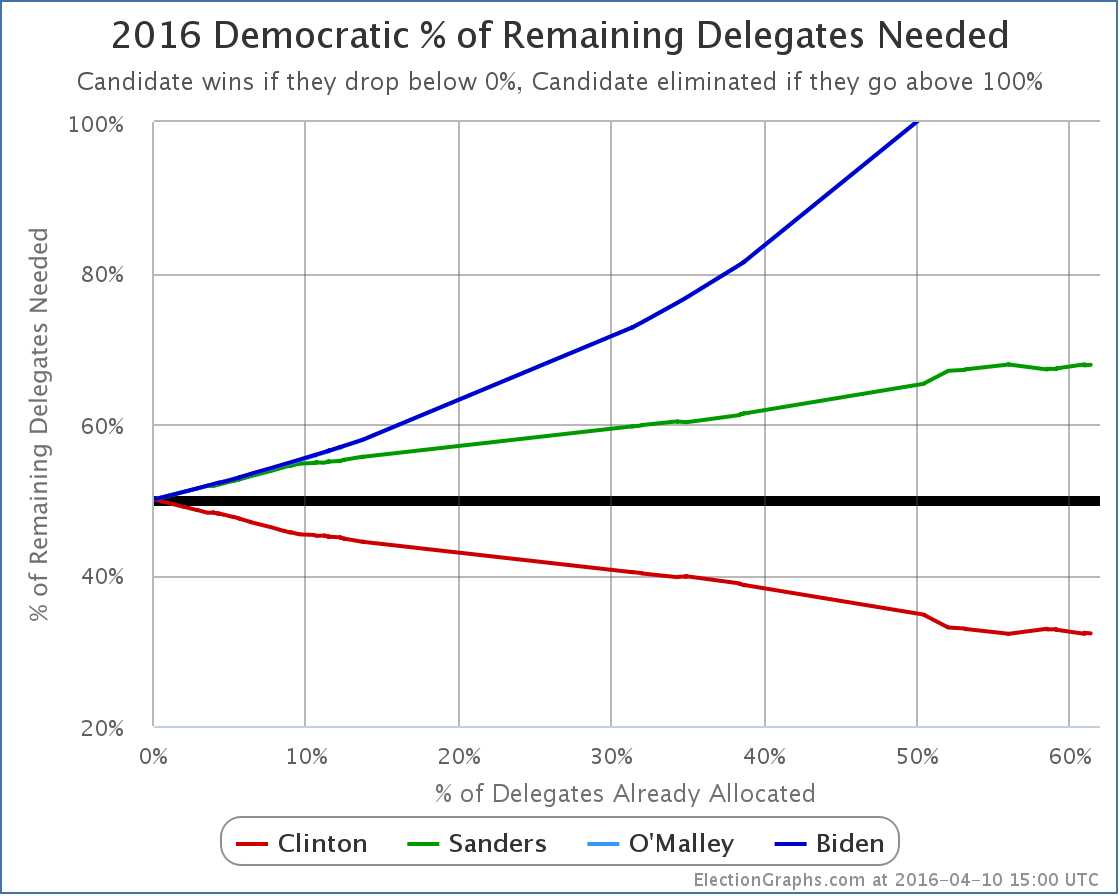
The percentage of the remaining delegates Sanders needs to win is now 67.84%. There have been some ups and downs, but basically Sanders had been able to keep things at 67.xx% since March 17th. This represents Sanders’ string of wins. Those wins have prevented Sanders’ situation from getting much worse, but critically he has not succeeded in actually bending his line downward to start heading to an actual win.
Clinton only needs 32.27% of the remaining delegates (including superdelegates) in order to win. This is not a high bar. To be absolutely clear here, this means Sanders could win every remaining contest by an absolutely stunning margin… and Clinton would still win the nomination because it wouldn’t be enough to catch up.
Of course, the Sanders argument is that if he did indeed continue winning almost every contest, the superdelegates would finally start coming to his side in large numbers, and would change those dynamics. Maybe. He has to actually do that first. And make sure that his efforts to sway the superdelegates don’t backfire and make them even more strongly committed to Clinton than they were before.
New York is up next of course. Clinton is currently leading the RCP poll average there by 14%. There are 247 delegates at stake. If the delegates in New York split according to current polls, then as a rough estimate Clinton will get 142 delegates and Sanders will get 105. That would leave Sanders needing 71.76% of the remaining delegates to catch up, and Clinton only needing 28.37% to get to the magic number and wrap things up.
The Sanders folks are tenacious, but actually winning the nomination would still take something catastrophic happening to Clinton’s campaign. The reason for Sanders to continue at this point is primarily to influence Clinton and pull her toward Sanders’ positions presumably. Unless the Sanders camp really is just hoping that Clinton will indeed implode at some point.
We will see.
[Update 2016-04-13 15:08 UTC – Superdelegate scan nets Clinton +4, Sanders +1. In addition an adjustment from Colorado yields Sanders +1, Clinton -1. Net for today’s changes, Clinton +3, Sanders +2.]
[Update 2016-04-17 02:20 UTC – Update from Colorado Democratic State Convention today. Net change: Sanders +2, Clinton -2.]
[Update 2016-04-17 14:19 UTC – Superdelegate scan nets Sanders +1, Clinton -1.]
[Update 2016-04-20 01:20 UTC – Superdelegate scan net: Clinton -2.]
Note: This post is an update based on the data on ElectionGraphs.com. Election Graphs tracks both a poll based estimate of the Electoral College and a numbers based look at the Delegate Races. All of the charts and graphs seen in this post are from that site. Additional graphs, charts and raw data can be found there. All charts above are clickable to go to the current version of the detail page the chart is from, which may contain more up to date information than the snapshots on this page, which were current as of the time of this post. Follow @ElectionGraphs on Twitter or like Election Graphs on Facebook to see announcements of updates or to join the conversation. For those interested in individual general election poll updates, follow @ElecCollPolls on Twitter for all the polls as they are added.
Cruz won Wisconsin decisively with 36 delegates to Trump’s 6. That’s 85.71% of the delegates.
Adding in other updates and delegate adjustments in Alaska, Colorado, American Samoa, Louisiana, and North Dakota that happened since my last post and you end up with a net change of Cruz +50, Trump +6, Rubio+4, Kasich +1. That’s 81.97% of the delegates for Cruz, which is pretty overwhelming.
But Cruz needed 83% and change to actually be on pace to win the nomination outright. He did that in Wisconsin, but when you factor in all of the other things since Arizona and Utah he falls a little bit short. The net result is he holds steady. Cruz now needs 83.64% of the remaining delegates to actually win outright.
Nobody expects Cruz to win delegates at that pace. The scenario where Cruz actually gets to 1,237 delegates before the convention is outrageously unlikely.
So lets look at the more relevant question. Does this stop Trump from getting to 1,237?
Well, it certainly makes it harder:
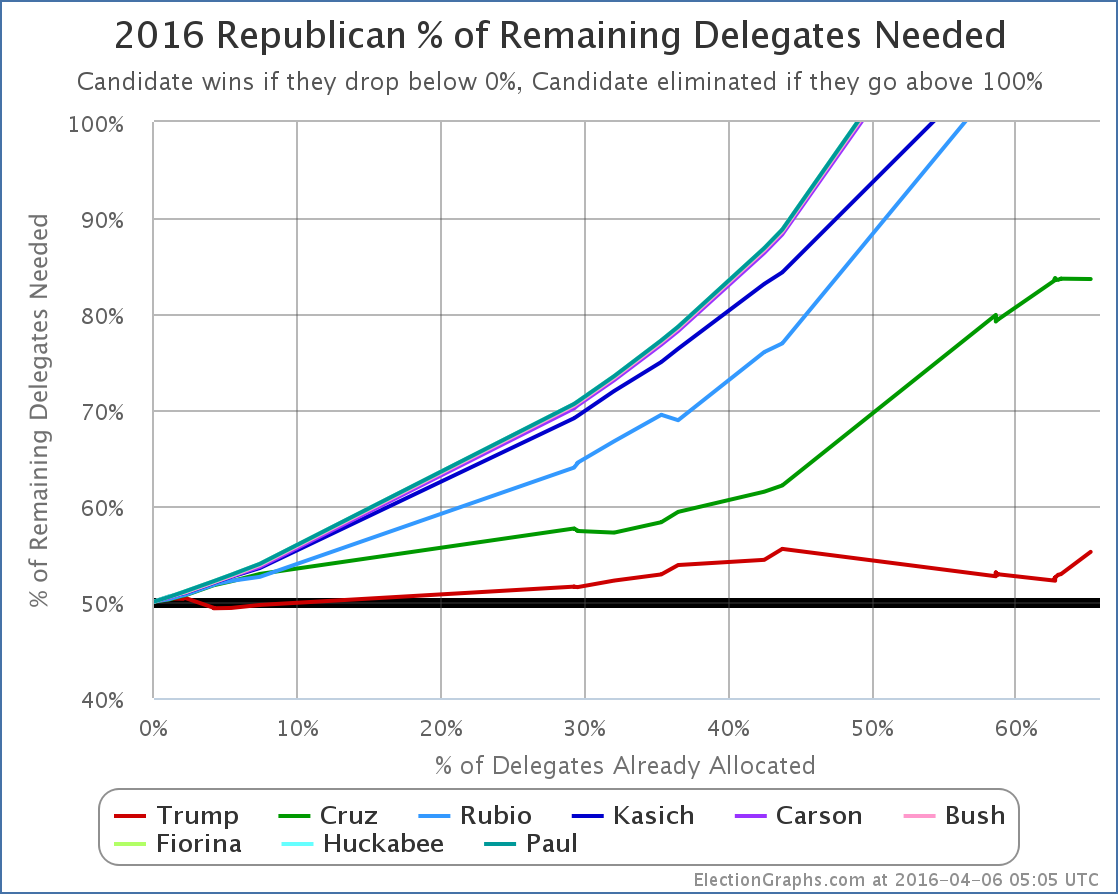
Between all of the things happening recently mentioned above, Trump goes from needing 52.22% of the remaining delegates to win outright, to needing 55.22%. Given that so far he has only managed 47.27%, this will clearly be a bit of a lift. If we had all proportional contests from here on out, it would probably be time to say it just wasn’t going to happen and buckle up for the contested convention.
Because of the craziness of winner take all and winner take most states though, we’re probably not quite there yet. But we’re a lot closer than we were before Wisconsin. But even that is complicated.
Taking Wisconsin into account, if you use 528’s “Can you get Trump to 1,237” calculator and follow the expert consensus projections, Trump falls about 55 delegates short. Now, they are giving Trump none of the uncommitted delegates. I agree that Trump won’t do well in this group, but zero seems a bit light.
The general picture though remains, which is that if all the remaining states go “as expected” Trump will fall slightly short of a majority of the delegates, and we’ll have a multi-ballot Republican convention for the first time since 1948. (The last time for the Democrats was 1952.)
To avoid this, Trump has to not just meet expectations in all of the coming states, but exceed them by just a little bit. With the drumbeat of perceived problems and missteps Trump has had in the last few weeks, this may seem unlikely. It may seem that Trump coming in below the current expectations is more likely. There has even been some talk that Trump has peaked and the long anticipated Trump collapse has now started.
A few weeks ago FiveThirtyEight projected Trump to get 25 of the 42 delegates in Wisconsin. The six Trump actually got is a long way from 25. That certainly seems to indicate we might be seeing a Trump collapse.
But wait… in the New York Times Nate Cohn gave Trump’s “expected” popular vote result in Wisconsin based on demographics and previous history as 35%. What was the actual result? 35.1%. That means that compared to where he was before, Trump’s performance didn’t actually constitute any sort of collapse. Trump is not in freefall. Instead, Trump came in pretty much where he was expected to in the popular vote.
So why the shellacking in delegates? It seems like this is due more to Cruz doing better than expected than to Trump doing worse than expected. The way this lined up in Wisconsin, it gave Cruz the overwhelming delegate win.
But this may or may not translate into other states. New York is not Wisconsin.
We will have some more information from Colorado this weekend and Wyoming next weekend. Trump is not expected to do very well in either, but we can look for clues in terms of if he meets or exceeds the projections there. But the next big bunch of delegates is April 19th in New York where Trump is expected to do very well. Then a lot of East coast states where Trump is also favored. But the question is not just “does Trump win” it is “does Trump win by enough”.
Right now, we are still in the zone where an outright Trump win is possible. But it requires Trump to improve on his performance so far, at a time where it seems like he is holding steady, but not really gaining ground. And despite not really taking aim at him until way later than many people thought they should have, the anti-Trump forces are now in full force, throwing everything they have at Trump. Improving his performance to the 55.22% of delegates average he needs to win outright may be a very tall order.
It may be slightly too soon to say that we are definitely going to have a multi-ballot contested convention… but the odds seem to be getting better by the day. And the chances that we will have some sort of craziness… the result of the first ballot determined by uncommitted delegates… or convention floor fights on rules changes or delegate credentialing that might impact the voting… seems to be very likely indeed.
So if you are a political junkie, go ahead and book July 18th to July 21st as days off from work, because there will almost certainly be fireworks of some sort, and you’ll want to be at home keeping up with the craziness minute by minute.
Right?
Or is that just me? :-)
[Update 2016-04-08 18:09 UTC – Results from Colorado’s 7th Congressional district in. Cruz +3. This doesn’t substantially change the analysis above.]
[Update 2016-04-09 16:24 UTC – Results from Colorado’s 2nd, 3rd, 4th and 5th Congressional districts: Cruz +12. Cruz has completely shut out Trump in Colorado’s 7 congressional districts. The statewide delegates will be determined later today. With the changes so far in Colorado, Trump now needs 56.20% of the remaining delegates to win.]
Note: This post is an update based on the data on ElectionGraphs.com. Election Graphs tracks both a poll based estimate of the Electoral College and a numbers based look at the Delegate Races. All of the charts and graphs seen in this post are from that site. Additional graphs, charts and raw data can be found there. All charts above are clickable to go to the current version of the detail page the chart is from, which may contain more up to date information than the snapshots on this page, which were current as of the time of this post. Follow @ElectionGraphs on Twitter or like Election Graphs on Facebook to see announcements of updates or to join the conversation. For those interested in individual general election poll updates, follow @ElecCollPolls on Twitter for all the polls as they are added.
Sanders won Wisconsin. Sanders got 48 delegates to Clinton’s 38. That’s 55.8% of the delegates.
Add in superdelegates and other changes since Washington, Hawaii and Alaska and it becomes Sanders +48.5, Clinton +44. That’s 52.4% for Sanders.
But Sanders needed 67.0% of the delegates to actually get closer to the nomination given that the pool of remaining delegates is dwindling. So the percentage of the remaining delegates Sanders needs to catch up and win increases despite the win.
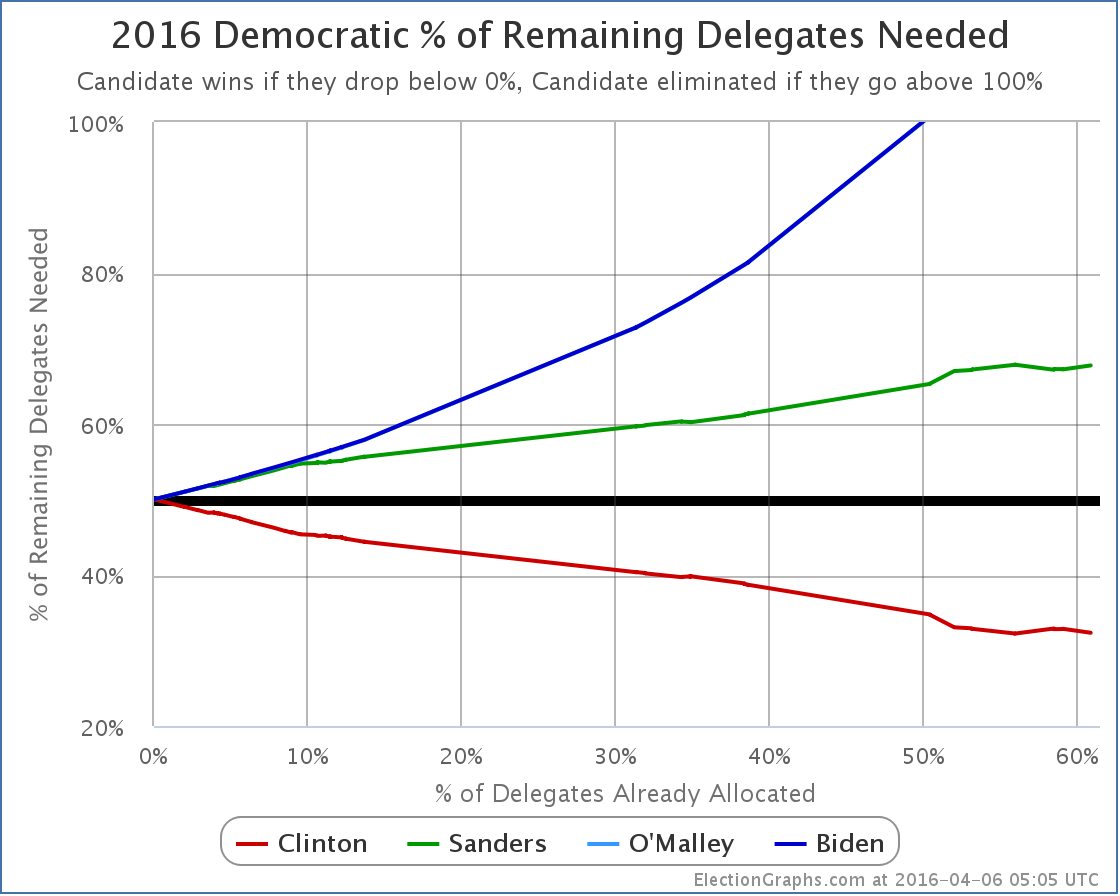
Before Washington, Hawaii, and Alaska, Sanders needed 67.84% of the remaining delegates to win. After his big wins in those contests, this declined to 67.03%. We’re now back to 67.76%. Sanders hasn’t lost all the ground he won, but he has lost most of it.
Winning states isn’t enough. To catch up Sanders would have to be routinely winning by massive margins. That hasn’t been happening.
In recent posts, I’ve also included calculations for an “if superdelegates didn’t exist” scenario. Even these show a very hard road for Sanders. Recently even some Sanders surrogates have started to acknowledge that catching Clinton in pledged delegates via primaries and caucuses may be a near impossible task.
Now the optimistic scenario for the Sanders camp seems to be that while they don’t catch Clinton in pledged delegates, they win so many states, are close enough, and have so much “momentum” that superdelegates going to Sanders would give him the nomination at the convention. Just a few weeks ago Sanders supporters were saying that superdelegates overturning the pledged delegate results would be a travesty of justice… but things change I guess.
We now essentially have even the Sanders camp saying the right way to look at the race is to include the superdelegates and their preferences. Because it is clear that any possible path to victory involves superdelegates.
Given that, there are about 207 superdelegates who have not yet expressed any preference that Sanders can woo. Just like delegates from primaries and caucuses, to be on a pace to catch up and win, Sanders needs to get over 67.76% of those delegates to come over to his side. Or, of course, he can try to convince some of the about 474 superdelegates who have already said they are supporting Clinton to change their minds.
So far there have not been any significant superdelegate moves toward Sanders.
If that does start to happen, you will of course see it here.
[Update 2016-04-08 17:57 UTC – Superdelegate scan plus updated results in Arizona and Kansas yield a net change of Clinton +2, Sanders +2. This does not substantially change the analysis above.]
[Update 2016-04-09 15:53 UTC – Superdelegate scan, net change: Sanders +4, Clinton -1.]
[Update 2016-04-10 14:59 UTC – Superdelegate scan, net change: Clinton +1, Sanders +1.]
Note: This post is an update based on the data on ElectionGraphs.com. Election Graphs tracks both a poll based estimate of the Electoral College and a numbers based look at the Delegate Races. All of the charts and graphs seen in this post are from that site. Additional graphs, charts and raw data can be found there. All charts above are clickable to go to the current version of the detail page the chart is from, which may contain more up to date information than the snapshots on this page, which were current as of the time of this post. Follow @ElectionGraphs on Twitter or like Election Graphs on Facebook to see announcements of updates or to join the conversation. For those interested in individual general election poll updates, follow @ElecCollPolls on Twitter for all the polls as they are added.
Although the best delegate tallies are still estimates that will almost certainly change a bit before they are final, the general outline will not change. Sanders crushed Clinton in all three states that caucused on March 26th. With Washington, Hawaii and Alaska together, the delegate haul was 104 for Sanders to only 38 for Clinton.
Since the last update Sanders has also been on a roll gaining four new superdelegates (while Clinton got no new supers), and having four delegates move from Clinton to Sanders as results in states that voted earlier got finalized.
Between all that, since the 23rd the net change is Sanders +112, Clinton +34.
So Sanders got a whopping 76.71% of the delegates since the 23rd. That is well above the 67.70% he needed to improve his position in the race in terms of the % of the remaining delegates needed to win. So unlike some Sanders “wins” where he gets the most delegates but still just ends up in a worse position because he didn’t win by enough, this time Sanders supporters are fully justified in celebrating the win.
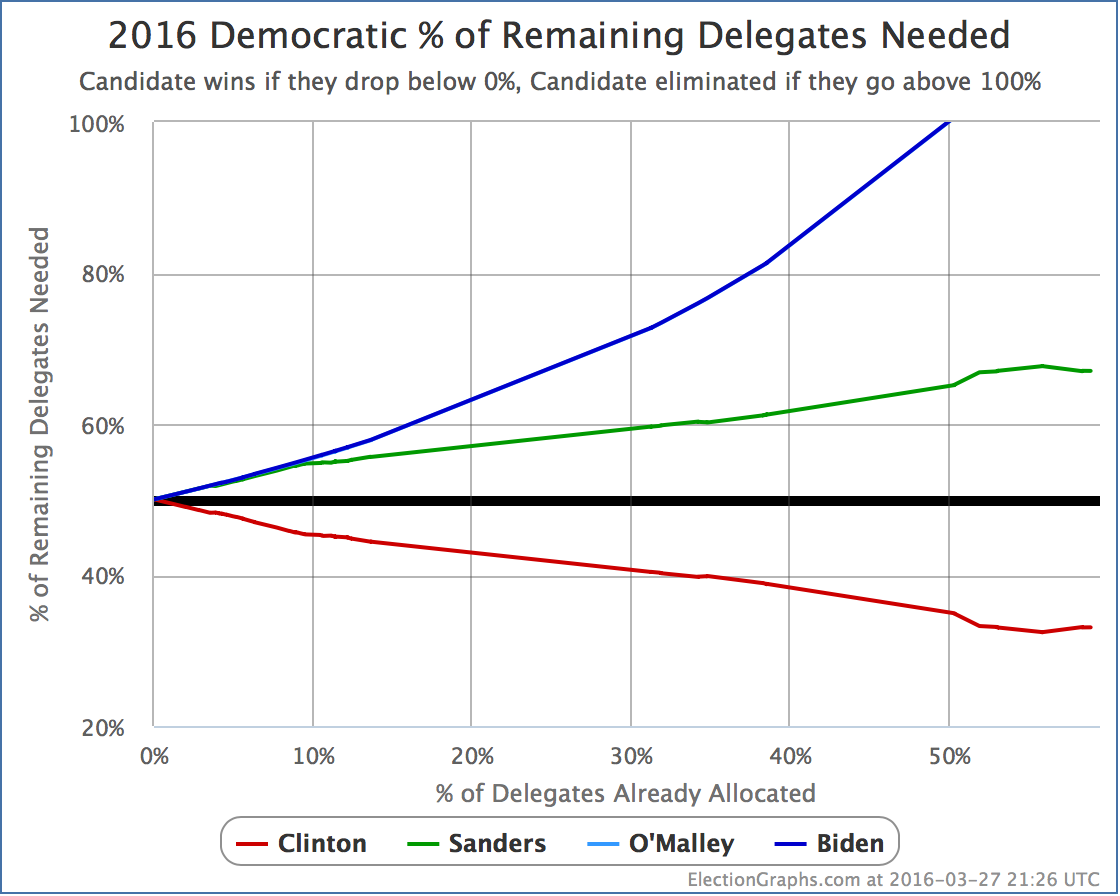
See that downward slope right neat the end of the green line? That is the improvement in Sander’s position because of these three states. Despite all the states that Sanders has won, this has not happened often. Aside from days when a stray superdelegate committed to him or when states revised their results by a delegate here or there, the only previous times so far where Sanders has improved his position are February 9th when he won New Hampshire and March 6th when he won Maine. (OK, probably Democrats Abroad too.) This new result on March 26th swamps both of those in the magnitude of the improvement.
With all of the results and adjustments since Arizona, Idaho and Utah last week, Sanders goes from needing 67.70% of the remaining delegates to win, to needing only… 67.03%.
So… an improvement of… 0.67%.
So, uh… big improvement? Suddenly the Sanders path to victory is clear? Well, it is the biggest improvement in this metric Sanders has seen yet, but…
No.
March 26th was a big Sanders win. That should not be minimized. If he matched the March 26th performance in every contest from here to the end of the primary season, he would indeed catch up to Clinton and win. And the visibility of wins like the 26th may help Clinton seem weak, and may improve Sanders’ performance in future contests.
But the basic situation has not changed significantly. 67% of delegates is still an incredibly high bar. Sanders would have to consistently meet that bar for the rest of the race in order to win outright.
But wait you say, once again this is all including superdelegates. But surely if Sanders won in pledged delegates, the superdelegates wouldn’t deny him the win and would switch to Sanders en masse because to do otherwise would be unseemly? Well, I generally reject starting with that premise and say lets watch the superdelegates and see what they actually do.
But for the moment, as I did once before, let me run the numbers pretending superdelegates don’t exist.
With supers the totals right now are Clinton 1735, Sanders 1069.5, O’Malley 1
Without supers that becomes Clinton 1264, Sanders 1040.
Without supers there are 4050 delegates, and you need 2026 to have a majority.
Sanders would need 976 more delegates to have that majority of pledged delegates. There are 1746 more pledged delegates available.
That means Sanders would need 55.90% of the pledged delegates remaining to end the season with a majority of the pledged delegates.
That bar is a LOT lower than 67%. Consistently beating 67% seems close to unimaginable without a complete implosion. But 56%? Could you get to that just through some momentum, some positive press cycles and good campaigning? Maybe. It seems like it is on the outer edge of the possible given the history so far, but still possible.
If Sanders did succeed at that, he would still need to get a large number of Clinton superdelegates to defect in order to actually win. But Sanders has said he is ramping up his efforts to woo superdelegates. He has gone from saying superdelegates should be ignored, to acknowledging that any realistic path to a win involves getting superdelegates to vote for him too.
If superdelegates do start to defect, you will of course see it on the graphs here.
One last comparison, updating the one I did two weeks ago:
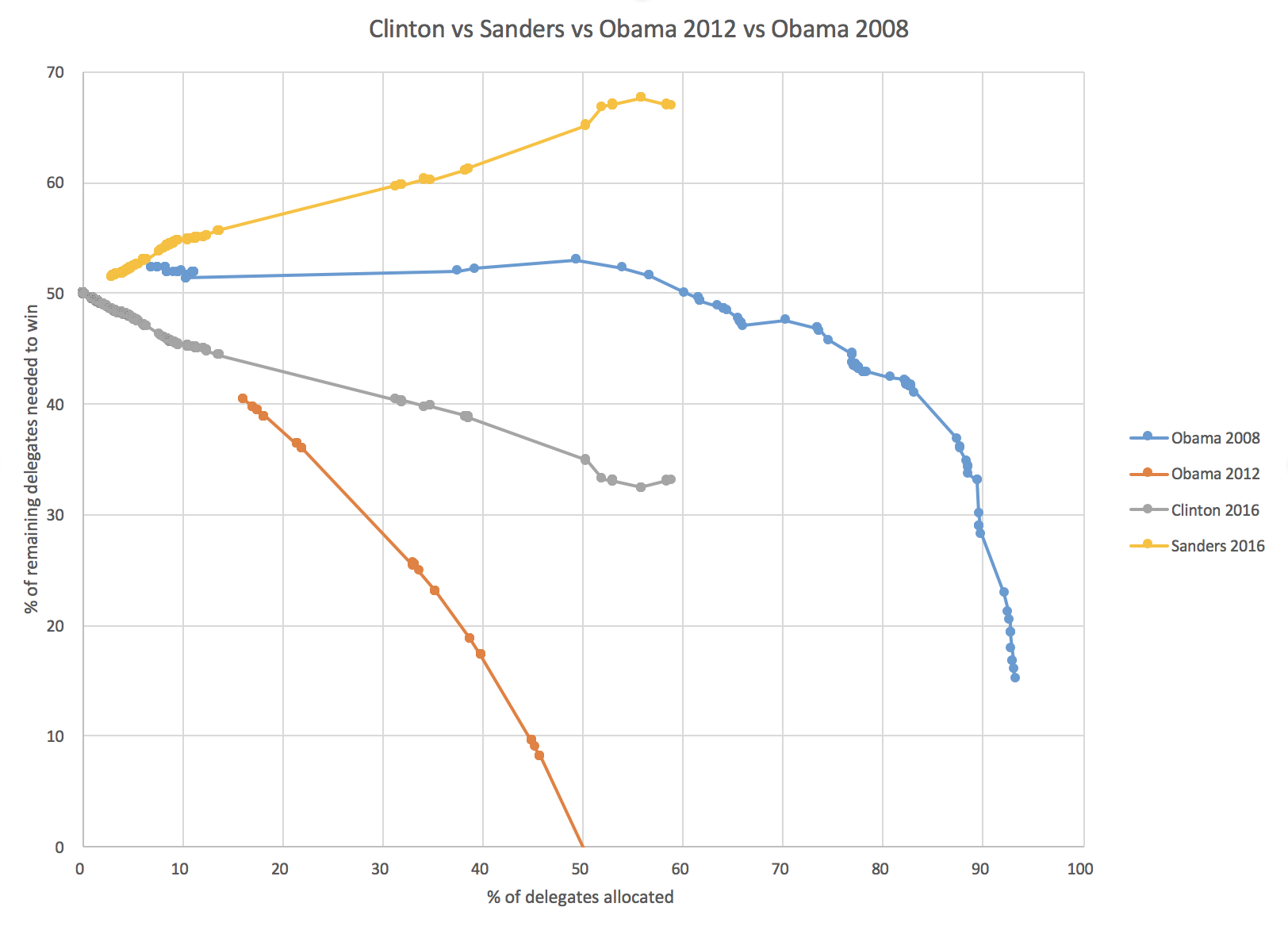
Granting for the moment the premise that the results on the 26th are not an outlier, but are instead indicative of an inflection point in the race, you see that compared to Obama 2008, Sanders starts his “turn” on the graph later (at about 56% rather than at about 49%) and that he is much much further behind that Obama was. Just barely past this point in 2008 is when Obama took the delegate lead. Sanders is far from that.
Meanwhile, Clinton is in a much stronger position than Obama was until very nearly the end.
If this is a “turn”, and Sanders drives his line down and eventually wins, it will be one of the largest come from behind wins in modern times. This is not impossible, but it is still highly unlikely.
Wisconsin is next on April 5th. Right now the RCP poll average there has Clinton 46.5% to Sanders 44.0%. If that average plays out and assuming a roughly even distribution of support throughout the congressional districts in the state, it would mean about 44 delegates for Clinton to 42 delegates for Sanders.
If that happened, Sanders would then need 67.87% of the remaining delegates to win, completely undoing the gains he made with Washington, Hawaii and Alaska.
Now, Sanders may get a boost of his recent wins and do better than the current poll average indicates. He may even win Wisconsin. The question though is not if he wins, but if he wins it by enough to actually be on a pace to catch up to Clinton before things are over. Right now, that means he needs 58 of the 86 delegates available from the Wisconsin primary.
We shall see.
[Update 2016-04-01 16:10 UTC – Superdelegate scan nets Clinton +3, Sanders +2.5. This does not significantly change the analysis above.]
[Update 2016-04-01 16:55 UTC – I found an update from Michigan which I had logged on March 10th, but had an error in it, so the totals in Michigan in the state detail table were correct, but that update wasn’t included in the national totals. Fixed now. Net change from that: Clinton +2, Sanders -2. This also does not significantly change the analysis above.]
[Update 2016-04-05 16:29 UTC – Superdelegate scan: Clinton +1. Note because Bill Clinton said something about how he would support Sanders at the convention if Sanders won, just like he supported Obama in 2008, some people are saying he should be listed as an Uncommitted superdelegate instead of a Clinton superdelegate. I don’t buy this at the moment and am continuing to list Bill Clinton as supporting Hillary Clinton.]
Note: This post is an update based on the data on ElectionGraphs.com. Election Graphs tracks both a poll based estimate of the Electoral College and a numbers based look at the Delegate Races. All of the charts and graphs seen in this post are from that site. Additional graphs, charts and raw data can be found there. All charts above are clickable to go to the current version of the detail page the chart is from, which may contain more up to date information than the snapshots on this page, which were current as of the time of this post. Follow @ElectionGraphs on Twitter or like Election Graphs on Facebook to see announcements of updates or to join the conversation. For those interested in individual general election poll updates, follow @ElecCollPolls on Twitter for all the polls as they are added.
[Edit 2016-03-28 00:05 UTC – Fixed one place I had Sanders’ name instead of Clinton.]
When I did my last update there hadn’t been any recent polls in either Arizona or Utah, but the results there ended up matching pretty well with the results of the few polls that came out since then. Namely, Trump won Arizona which was straight up winner take all, and Cruz got over 50% in Utah, so he got all of the delegates there.
So the net for the night was Trump +58, Cruz +40.
Adding in other delegate adjustments since the March 15th results we have a net change of:
Trump +62, Cruz +43, Rubio -3
So effectively, Trump got 60.78% of the delegates since the last update. He only needed 53.07% to improve his position.
So what does this look like?
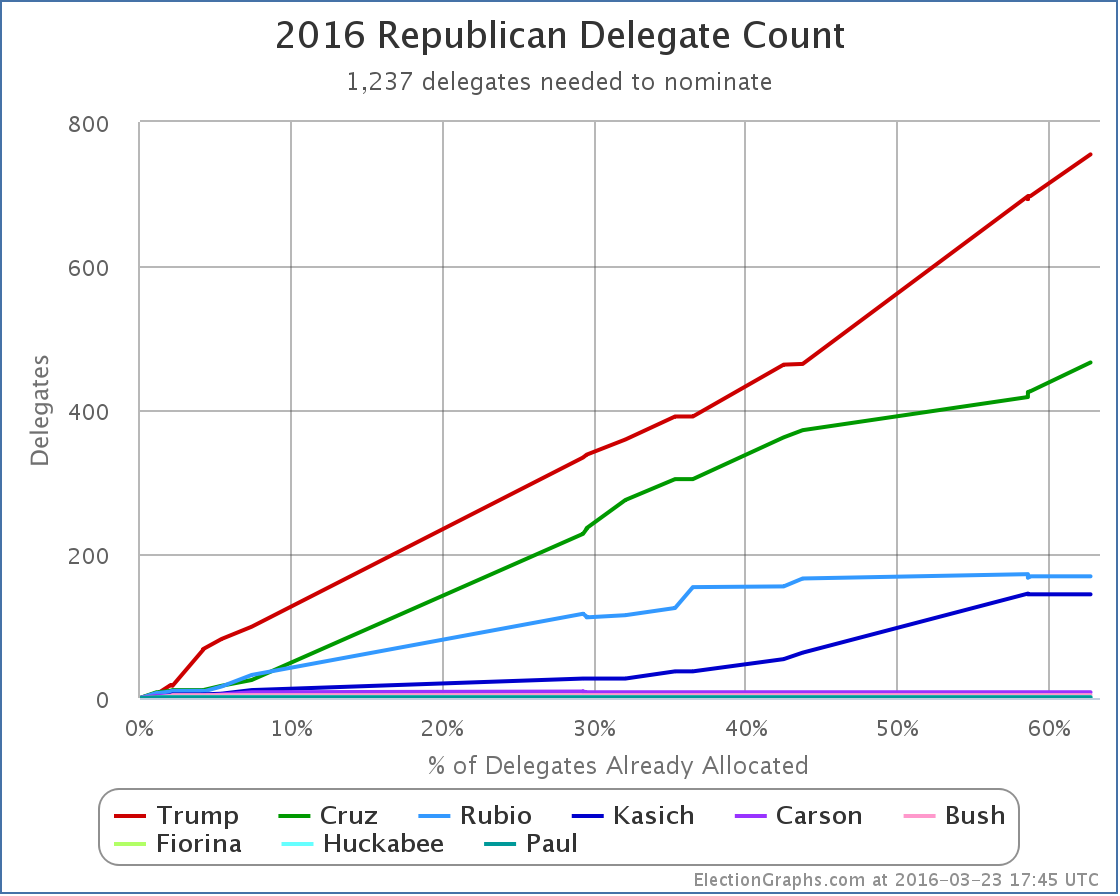
The raw delegate count is now Trump 755, Cruz 466, Rubio 169, Kasich 144, Carson 8, Bush 4, Fiorina 1, Huckabee 1, Paul 1
Trump’s pace of delegate accumulation actually looks like it has accelerated, while everybody else has slowed down.
But the raw delegate counts are not the right thing to look at.
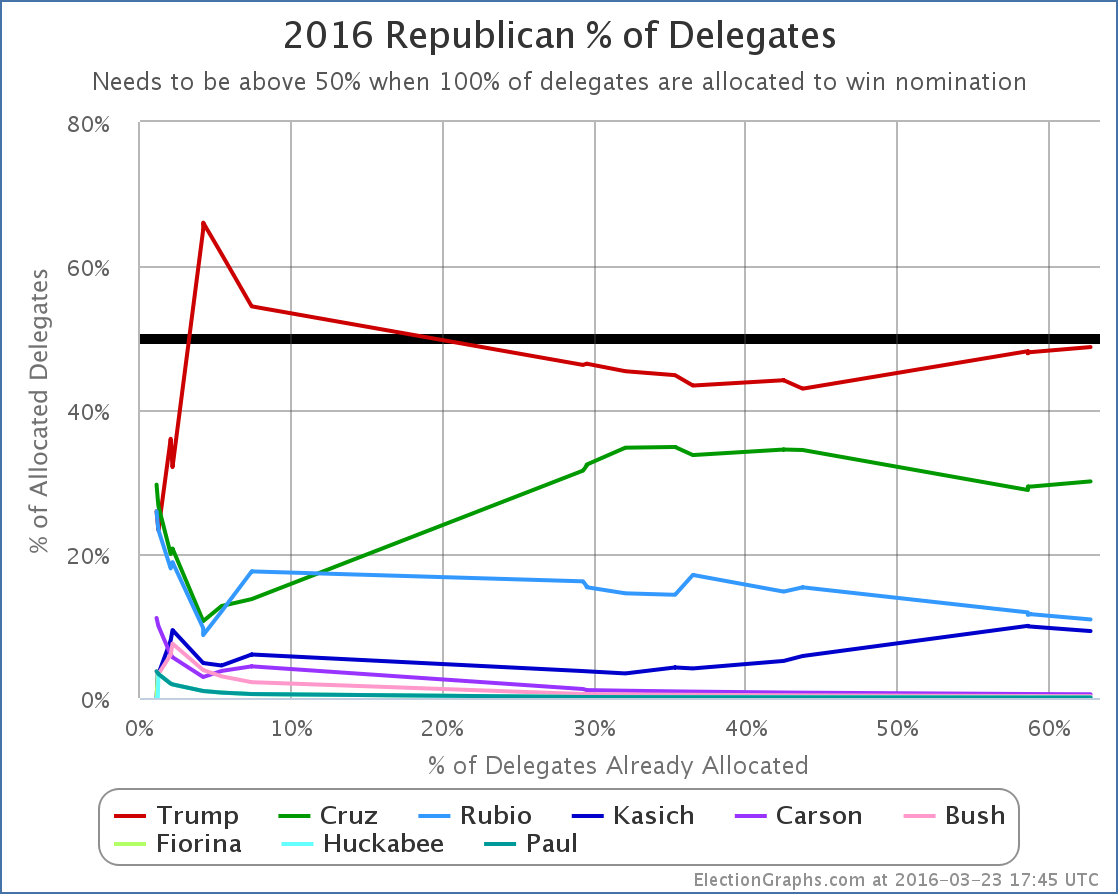
In percentages of the delegates so far, both Trump and Cruz improved. But of course Cruz is nowhere near the 50% line. Trump meanwhile is now at 48.74%. He doesn’t have a majority. Close. Very close. But not quite.
But % of delegates so far isn’t the right thing to look at either.
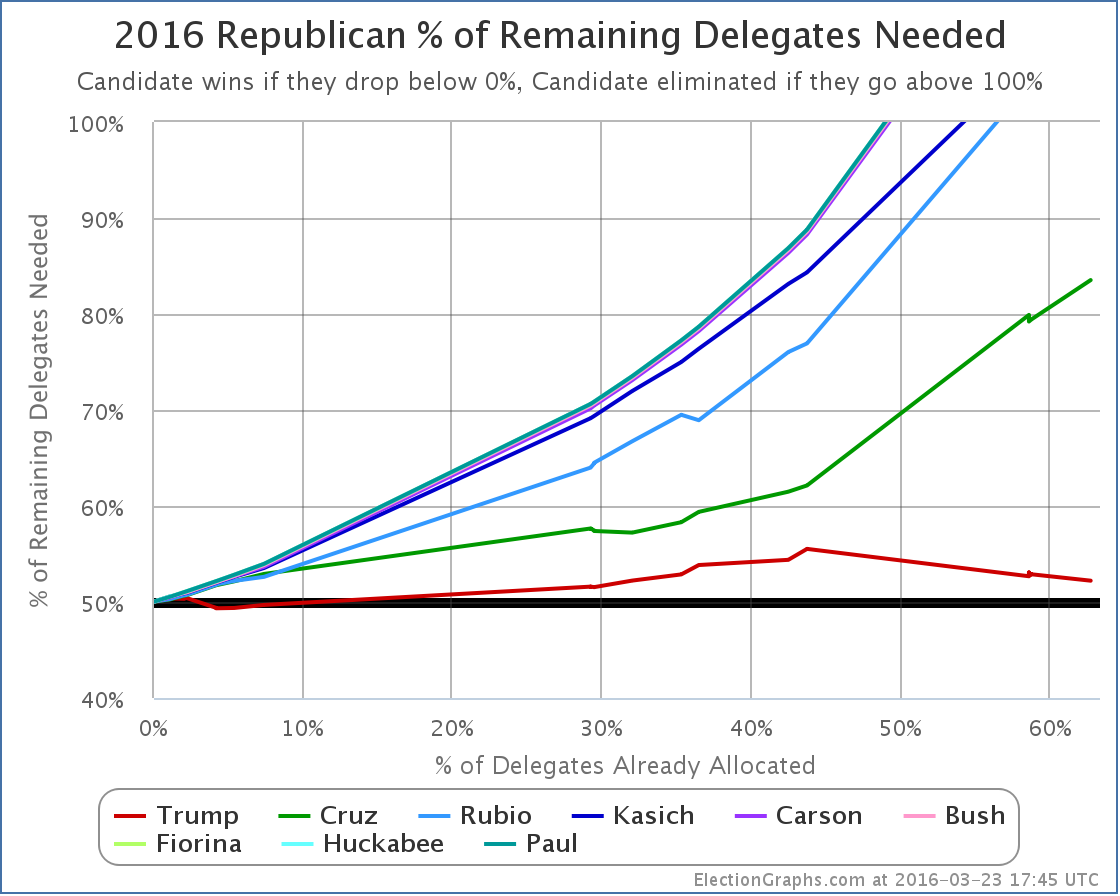
This is the real graph to watch. The percentage of the remaining delegates that Trump needs to win in order to get to the convention with a majority of delegates. This has been dropping in the last couple of contests.
Trump now needs 52.22% of the remaining delegates to win the nomination outright.
Now, some of those “remaining delegates” are 18 delegates who have already been selected as officially “uncommitted” delegates, and there will be more uncommitted delegates coming out of some of the states that have yet to vote. Probably a few dozen to as many as 100. These delegates are essentially like the Democratic superdelegates in that they can vote however they feel like and are not bound to the results of any primaries or caucuses.
If you wanted to calculate the percentage Trump would need without uncommitted delegates, it would be higher. But just like superdelegates are part of the process on the Democratic side, uncommitted delegates are part of the process on the Republican side, and to get a fair picture you need to include them.
You just have to realize that winning not only includes earning pledged delegates, but also convincing uncommitted delegates to vote for you.
It is a real possibility that we could get to the end of the primaries and caucuses in June without knowing if Trump has an outright win, or if he’ll come up short on the first ballot at the convention. It might end up depending on what those uncommitted delegates decide to do.
We are still right on the edge between a Trump win and a convention where nobody wins on the First ballot. And which way that goes may end up depending on the uncommitted delegates. What percentage of the uncommitted delegates Trump would need… if he even needs them at all… will depend on how he continues to do in getting pledged delegates between now and June.
But meanwhile, the pace of primaries and caucuses now slows down quite a bit. So there will be a lot of waiting before we know.
[Update 2016-04-01 17:15 UTC – Alaska gave back Rubio’s delegates after he asked, and Oklahoma finalized their results. Net change: Rubio +4, Cruz -2, Trump -3. This does not substantially change the analysis above.]
[Update 2016-04-04 05:43 UTC – Most of Colorado’s delegates will be determined next weekend, but the 6 representing the 1st and 6th congressional districts were determined this weekend, and all 6 went to Cruz. With this and the change above, Trump’s percentage of remaining needed to win is up to 52.83%. Adding this note here rather than doing a full post on those six delegates.]
[Update 2016-04-04 14:15 UTC – As of April 4th there were 28 “unbound” Republican delegates, with more to come soon. These are free agents like the Democratic superdelegates. I have started to track them individually when there is evidence of a known preference. So far, adding them in nets: Cruz +3, Trump+2.]
[Update 2016-04-06 02:01 UTC – Added in tentative evaluations of the uncommitted delegates from North Dakota. Net: Cruz +7, Trump +1, Kasich +1.]
Note: This post is an update based on the data on ElectionGraphs.com. Election Graphs tracks both a poll based estimate of the Electoral College and a numbers based look at the Delegate Races. All of the charts and graphs seen in this post are from that site. Additional graphs, charts and raw data can be found there. All charts above are clickable to go to the current version of the detail page the chart is from, which may contain more up to date information than the snapshots on this page, which were current as of the time of this post. Follow @ElectionGraphs on Twitter or like Election Graphs on Facebook to see announcements of updates or to join the conversation. For those interested in individual general election poll updates, follow @ElecCollPolls on Twitter for all the polls as they are added.
With Arizona, Idaho and Utah weighing in, Sanders won 74 delegates to Clinton’s 57. That’s a big win for Sanders. But it is only 56.49% of the delegates. To actually improve his overall position, Sanders would have needed 67.06% of the delegates. He didn’t reach that level, so the Sanders path to the nomination gets even harder.
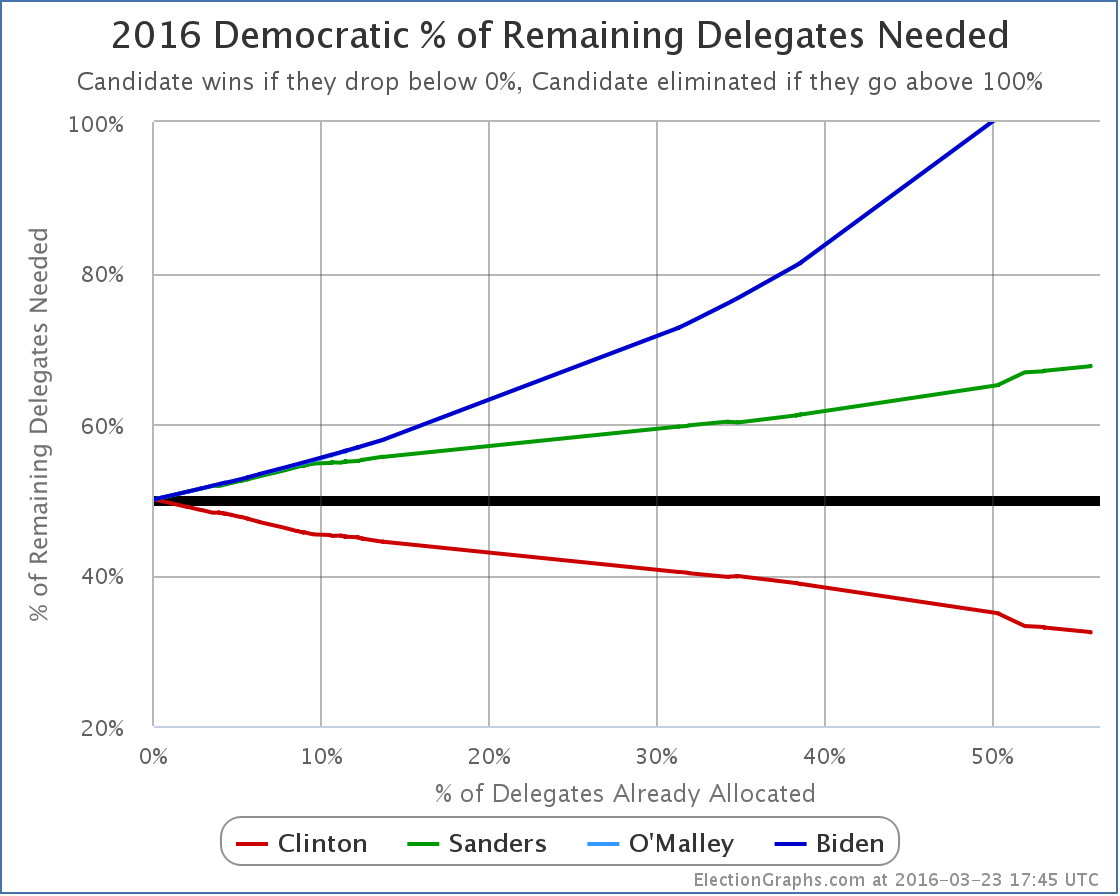
Also including an additional Sanders superdelegate that was added to the totals since the last update, Sanders now needs 67.70% of the remaining delegates to catch up and win. Or, as usual, a huge number of Clinton superdelegates changing their minds could change everything. That seems increasingly unlikely the closer Clinton gets to the nomination of course. But if it happens, you’ll see it here.
[Update 3/26 21:14 UTC – Updates in preparation for new results tonight. Superdelegate changes: Sanders +4. Updates from FL/GA/AZ net: Sanders +4, Clinton -4.]
Note: This post is an update based on the data on ElectionGraphs.com. Election Graphs tracks both a poll based estimate of the Electoral College and a numbers based look at the Delegate Races. All of the charts and graphs seen in this post are from that site. Additional graphs, charts and raw data can be found there. All charts above are clickable to go to the current version of the detail page the chart is from, which may contain more up to date information than the snapshots on this page, which were current as of the time of this post. Follow @ElectionGraphs on Twitter or like Election Graphs on Facebook to see announcements of updates or to join the conversation. For those interested in individual general election poll updates, follow @ElecCollPolls on Twitter for all the polls as they are added.
[Edit 18:14 to fix the date in the title.]
Just a small number of delegates, but we did finally get results from the Democrats Abroad primary that was held earlier in the month:
Sanders 9, Clinton 4.
With this change alone, Sanders did get a high enough percentage of delegates (69.2%) that his “% of remaining delegates needed to win” would have improved. But there were other delegate changes in the six days since the last primary results as well.
The last Democratic post was done while many delegates from Florida and Illinois were still to be determined, because for some reason those states were super slow and it took about two days for everything to be settled. That info was added to that post as an update, but for completeness here, from those final updates, Clinton gained 85 more delegates and Sanders added 43. In addition there were superdelegate updates. Net superdelegate change was Clinton +5, Sanders +0.5. The half delegate is from a Democrats Abroad superdelegate, who only gets a half vote.
With all that, the Democrats Abroad results are actually overwhelmed by the other updates and the new totals are:
Clinton 1644, Sanders 882.5, O’Malley 1
Translating that into the all important “% of remaining delegates needed” graph:
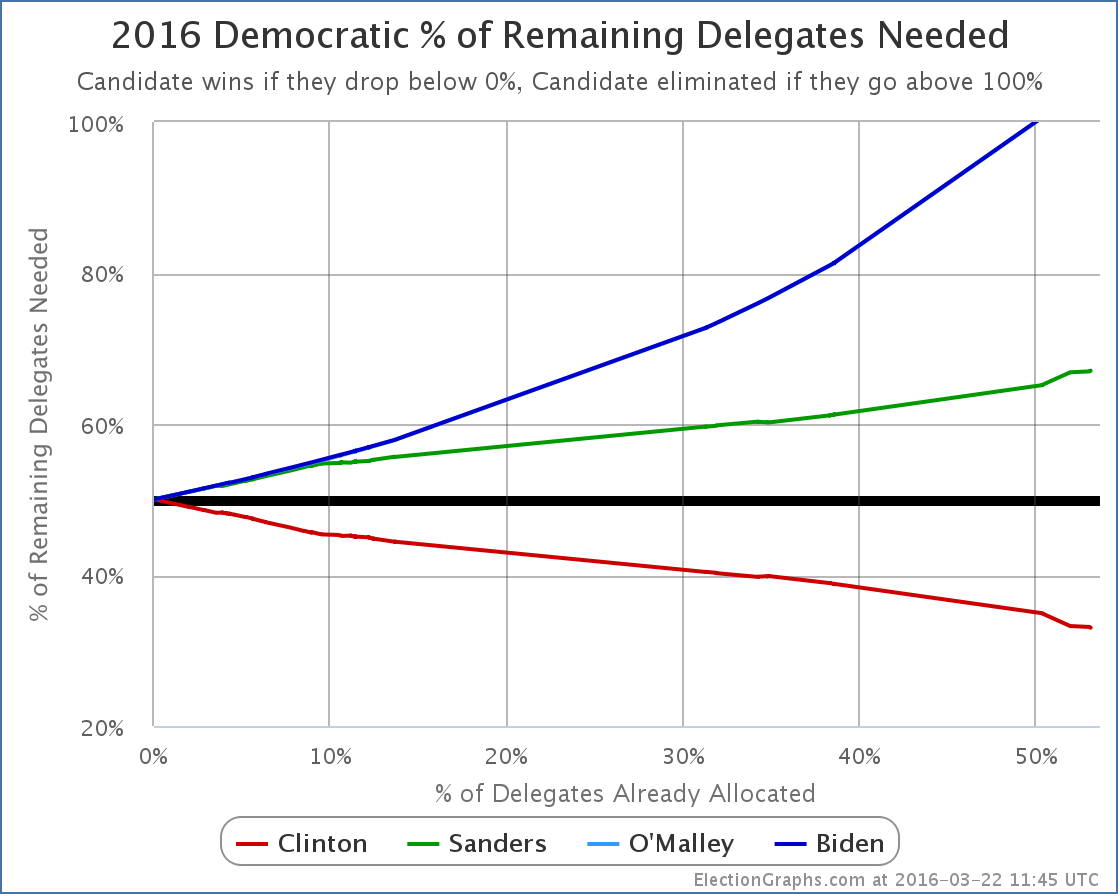
As of now, Clinton needs 33.03% of the remaining delegates to win. Sanders needs 67.06%.
That includes superdelegates of course, and superdelegates can change their minds. If Clinton superdelegates defect to Sanders, Clinton would need more and Sanders would need less. Such defections have been very rare so far however. If they do start to happen, you’ll see it in these charts.
Until then though, this is where we sit. Up next: Arizona, Utah and Idaho.
[Update 2016-03-23 01:34 – Superdelegate scan, Net Sanders +1]
Note: This post is an update based on the data on ElectionGraphs.com. Election Graphs tracks both a poll based estimate of the Electoral College and a numbers based look at the Delegate Races. All of the charts and graphs seen in this post are from that site. Additional graphs, charts and raw data can be found there. All charts above are clickable to go to the current version of the detail page the chart is from, which may contain more up to date information than the snapshots on this page, which were current as of the time of this post. Follow @ElectionGraphs on Twitter or like Election Graphs on Facebook to see announcements of updates or to join the conversation. For those interested in individual general election poll updates, follow @ElecCollPolls on Twitter for all the polls as they are added.
In my last post on the Republicans I used current polls to try to guess the March 15th results. This was my guess:
Trump +226, Kasich +86, Cruz +36, Rubio +19
Results are not yet final in Missouri, and because it is winner take all in each congressional district as well as statewide, and it is close in most congressional districts, things could still swing there quite a bit. But for the moment, with the best estimates I had from Green Papers, the actual results from the 15th were:
Trump +229, Kasich +81, Cruz +51, Rubio +6
Cruz got a bit more than my predictions, Rubio a bit less. But basically using the polls a couple days out got things pretty spot on. So minus any big changes from Missouri or minor adjustments elsewhere, this was the expected scenario.
So time to look at some graphs, including some I don’t usually bother with…
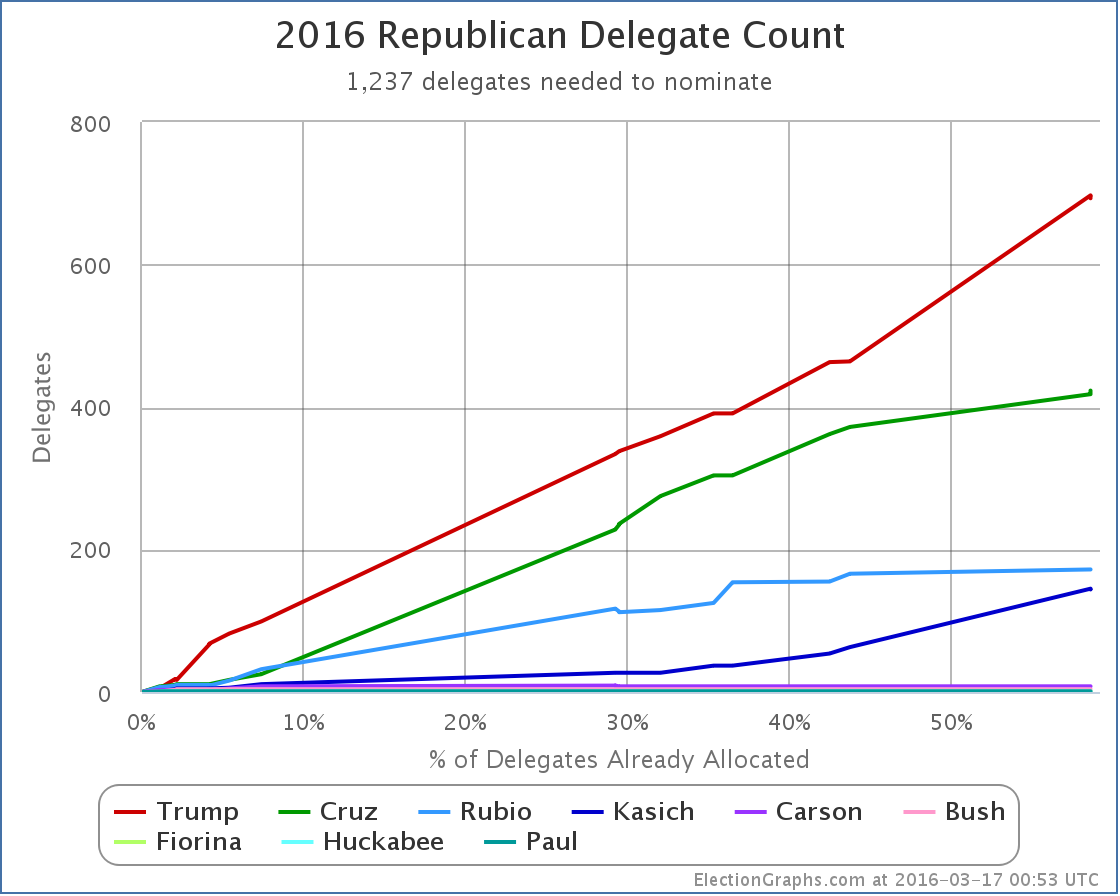
In raw delegate counts we now have:
Trump 693, Cruz 423, Rubio 172, Kasich 144, Carson 8, Bush 4, Fiorina 1, Huckabee 1, Paul 1
Trump, Cruz and Kasich both look like they made significant improvements, but…
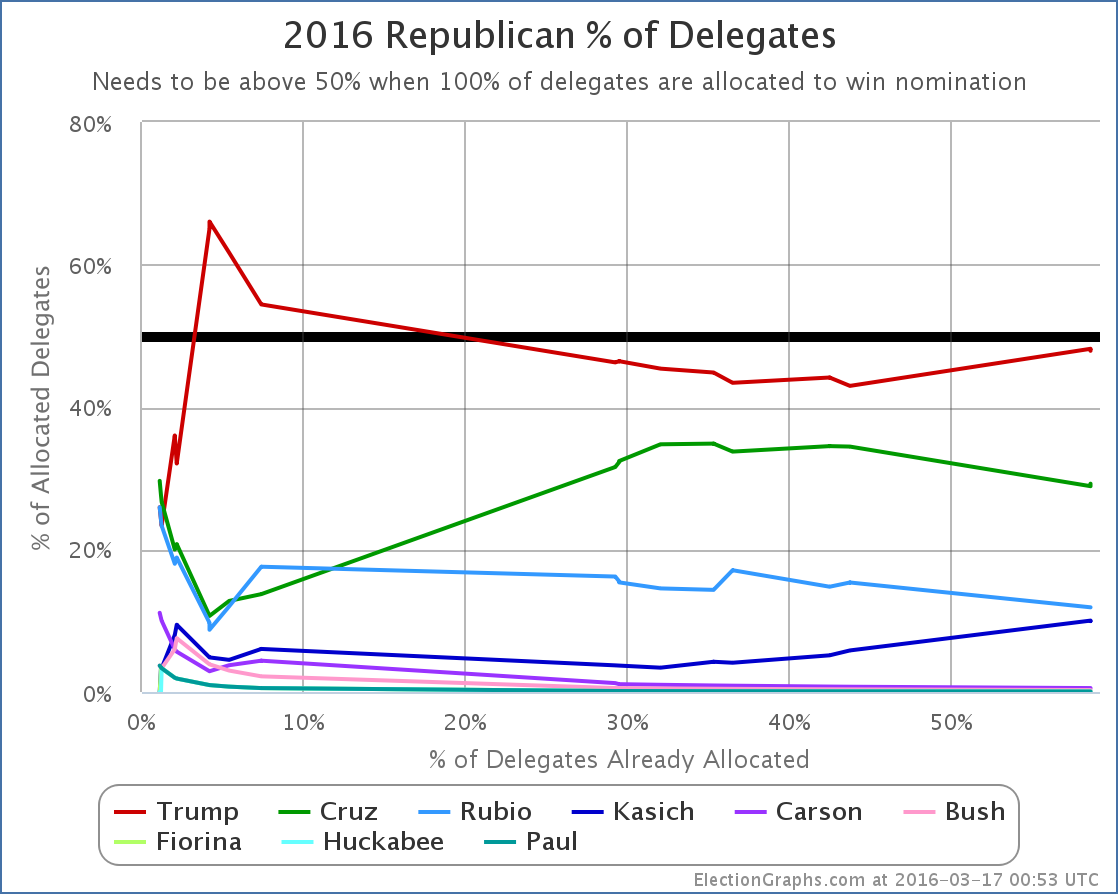
This is the percentage of delegates allocated so far to each candidate. Trump is just BARELY under the 50% mark. Only Trump and Kasich improved on this metric with the March 15th results.
But… looking at the much more useful “% of remaining delegates needed to win” graph…
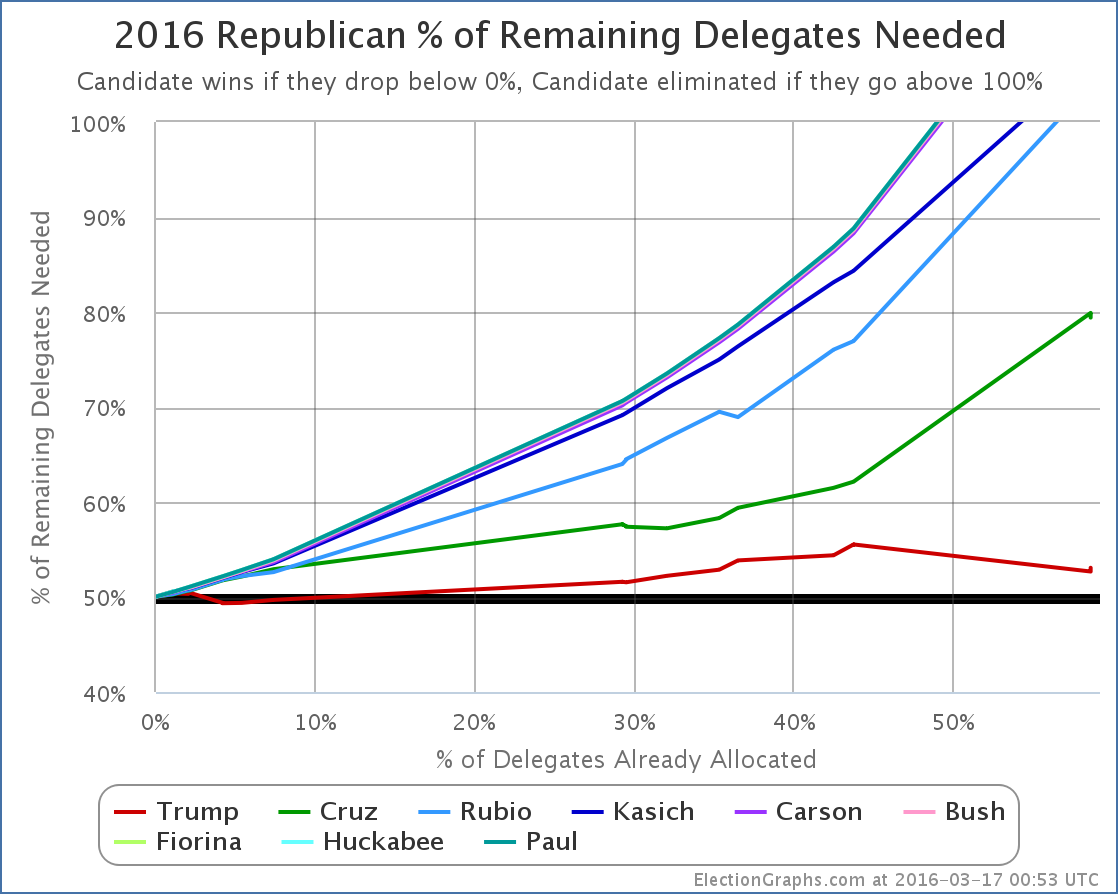
Everybody except Trump got further away from the nomination after March 15th. In fact, all of them got a LOT farther from the nomination. In fact, almost all the candidates have now been mathematically eliminated from a first round convention win. We knew for a long time that Paul, Huckabee, Fiorina, Bush and Carson were headed there. But it is now official. But Rubio was also eliminated. And despite his “big win” in Ohio, so was Kasich. All of these candidates could get every delegate still outstanding… and still not end up with enough delegates to win.
Only Trump and Cruz still have the possibility of collecting a majority of the delegates before the convention. And Cruz just went from needing 62.14% of the remaining delegates, to needing 79.41%. This is a completely unrealistic number, even if it was a two person race between him and Trump. (For the moment, despite it being impossible for him to get enough delegates, Kasich is staying in, so we still have a three way split, which favors Trump.)
Trump needs 53.07% of the remaining delegates to win outright. Less than that will get us to a contested convention and all kind of chaos. But how likely is Trump to get those sorts of margins? So far of course he has only gotten 47.89% of the delegates. So he does have to improve on his previous performance by about 11%.
This sounds like a lot, but it is probably quite reachable. First, Trump will undoubtedly pick up some of Rubio’s supporters, they won’t all go to Cruz and Kasich. Second, there are a number of winner take all states coming up. Third, a lot of the states that are not winner take all are still winner take most.
Basically, the structure of the primary calendar is DESIGNED to help the front running candidate wrap things up. It is not unreasonable to think Trump will be able to do that. To stop it, Cruz and Kasich between them need to be getting more than a majority of the delegates despite the fact that neither of them has a realistic shot at an outright win. The only plan for those two is to force the contested convention, then win there.
Some places have tried to game out all of the remaining primaries and caucuses, and they conclude that we may in fact not know if we have an outright Trump win or a contested convention until the very last contests on on June 7th. That would be California, Montana, New Jersey, New Mexico and South Dakota. And there is a possibility we won’t even know until after that, because although their numbers are small, some states and territories have actually elected uncommitted delegates, who like superdelegates on the Democratic side are free agents able to vote however they see fit. There is a posisbility (a small one, but non-zero) that these uncommitted delegates may be in a position to determine if there will indeed be a contested convention.
I won’t try to game out the rest of the season, but I will look at next Tuesday… Arizona, Utah, and American Samoa. As usual, looking at RCP for polls, and Green Papers for delegate rules. But guess what? As of today, there has been NO recent polling on any of these three. So we’ll use national polling, but eliminating candidates who have dropped out. So Trump 36.0%, Cruz 21.8%, Kasich 12.0%. Normalized to 100%, that is Trump 51.6%, Cruz 31.2%, Kasich 17.2%..
- Arizona is winner take all. Unless Cruz or Kasich are doing much better there than nationally, Trump gets all 58 delegates.
- Utah is winner take most. If anybody gets over 50%, they get all the delegates. If the estimates above based on national polling are right, Trump gets all 40 delegates. If he doesn’t hit 50%, but still gets a plurality, he is likely to still get almost all the delegates. We’ll estimate 40 to Trump.
- American Samoa might end up electing someone with a commitment, but the expectation given their rules is that all delegates will be uncommitted, so they will just stay TBD in my counts.
Now, either Arizona or Utah COULD go in a completely different direction. As I said, there has been no recent polling. So who really knows? But if Trump ends up winning both, he will likely get something close to 98 delegates out of the two states.
If that happened, that would put the total delegate count at:
Trump 791, Cruz 423, Rubio 172, Kasich 144, Carson 8, Bush 4, Fiorina 1, Huckabee 1, Paul 1
That would give Trump 51.20% of the delegates. He would once again have a majority of the delegates. Trump would then need 446 delegates to win outright. There would be 927 delegates left undetermined at that point. So Trump would only need 48.11% of the remaining delegates to win. Which given his history at that point seems quite reachable.
But continuing to block him might still be within reach. Cruz + Kasich would only need to manage about 52% of the delegates. Which might be possible if they could build on anti-Trump sentiment even in the face of Trump winning. If they can do that is a big open question though. The “I can’t win, and you might not even like me, but vote for me to block the other guy and cause a contested convention where the outcome is completely unknown” case may not be the easiest one to make.
But if Cruz and Kasich can make that case, then it is not over yet.
So then we start looking at North Dakota, Wisconsin, Colorado… and beyond.
Of course, if Trump loses Arizona or Utah, that all changes.
So we will have to wait and see… but if I had to put odds on it, I’m still thinking about an 80% chance that Trump just wins this outright. The structure of the contests themselves are designed to help the front runner, and that is Trump.
[Update 2016-03-18 06:21 UTC – As per Alaska’s rules, after Rubio dropped out they reassigned his delegates to the remaining candidates. Result: Trump +3, Cruz +2, Rubio -5.]
[Update 2016-03-23 01:43 UTC – The Virgin Islands updated their delegate results because the original slate of delegates (all uncommitted) did not end up qualifying under the rules (see here). The original delegates were replaced by alternates. The result for the counts was Rubio +2, Cruz +1, Trump +1.]
Note: This post is an update based on the data on ElectionGraphs.com. Election Graphs tracks both a poll based estimate of the Electoral College and a numbers based look at the Delegate Races. All of the charts and graphs seen in this post are from that site. Additional graphs, charts and raw data can be found there. All charts above are clickable to go to the current version of the detail page the chart is from, which may contain more up to date information than the snapshots on this page, which were current as of the time of this post. Follow @ElectionGraphs on Twitter or like Election Graphs on Facebook to see announcements of updates or to join the conversation. For those interested in individual general election poll updates, follow @ElecCollPolls on Twitter for all the polls as they are added.
[Edit 02:27 UTC to add final bit about odds.]
As of when I started writing this post, the results from the March 15th contests on the Democratic side were:
Clinton +312, Sanders +251, TBD 128*
In addition, since the last post other revisions netted: Clinton +3, Sanders +1.
So of the delegates allocated since that last update, Clinton got 55.6%. She only needed 38.90% of the delegates to be on pace to win.
So the updated “% of remaining needed to win” graph looks like this…
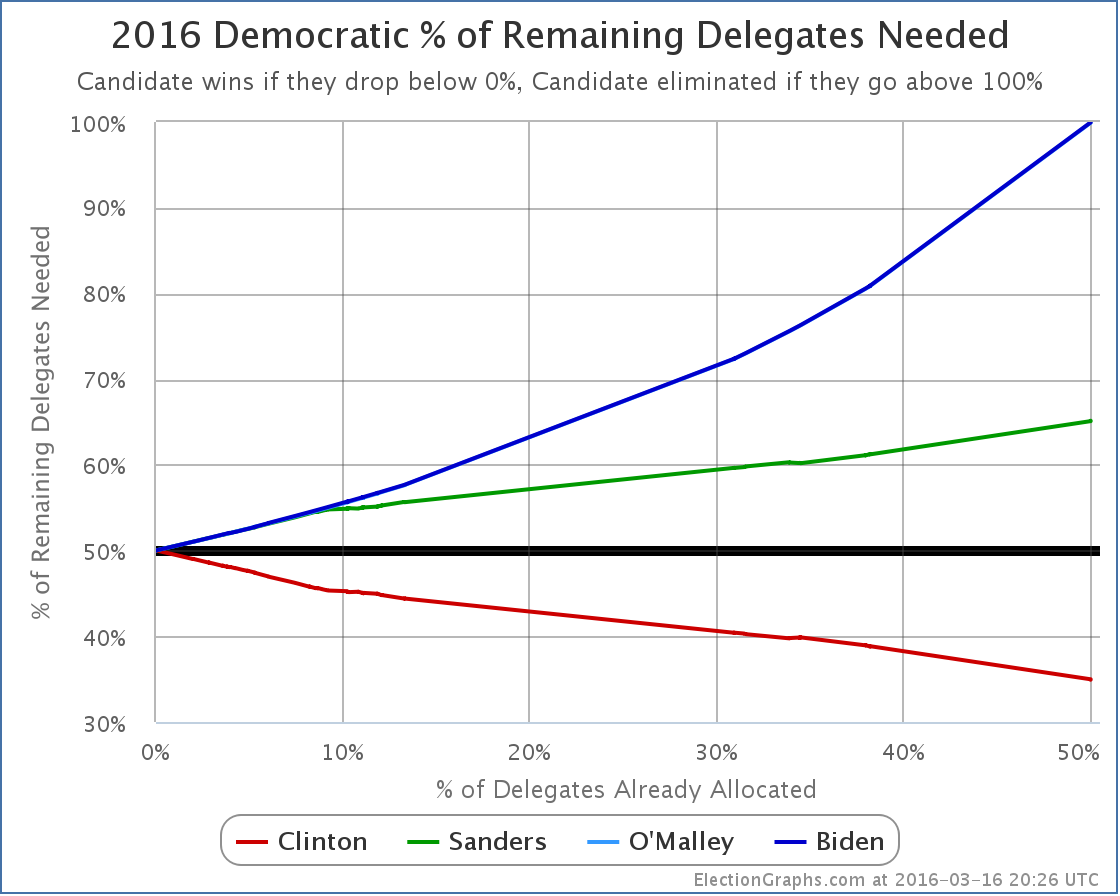
Clinton only needs 34.94% of the remaining delegates to win.
Of course, if massive numbers of superdelegates start changing their minds, that number would get higher. Enough superdelegates flipping could in fact still put Sanders in the lead!
But superdelegates haven’t been changing their minds in significant numbers yet.
And so Clinton’s delegate accumulation continues.
* I waited awhile before writing this post because the final disposition of 64 delegates each from Florida and Illinois is still undetermined as per my source (Green Papers). But at some point I had to go ahead with what I had. Those delegates are likely to split along the same lines as the other delegates from those states though, and they are unlikely to change the overall picture. If there are additional updates for those delegates before the results from Arizona, Idaho and Utah come in, I will add updates to the post with those results.
[Update 2016-03-17 00:30 UTC – And here is the first of those updates. With updates to both Florida and Illinois, Clinton added 64 more delegates, and Sanders added 11. All 64 TBD delegates from Florida are now accounted for. There are still 53 delegates TBD in Illinois. Clinton now only needs 33.30% of the remaining delegates, while Sanders needs 66.78%. In addition, with this update O’Malley is officially mathematically eliminated.]
[Update 2016-03-18 05:20 UTC – Update today for both Illinois and Ohio. Net result Clinton gained another 21 delegates, Sanders gained 32. There are no more TBD delegates remaining. Clinton now needs 33.16% of the remaining delegates while Sanders needs 66.93%.]
[Update 2016-03-18 05:41 UTC – Superdelegate scan, Net: Clinton -1]
[Update 2016-03-20 16:12 UTC – Superdelegate scan, Net: Clinton +1]
[Update 2016-03-22 11:27 UTC – Superdelegate scan: Net: Clinton +5, Sanders +0.5 (Democrats Abroad superdelegates get half a vote)]
Note: This post is an update based on the data on ElectionGraphs.com. Election Graphs tracks both a poll based estimate of the Electoral College and a numbers based look at the Delegate Races. All of the charts and graphs seen in this post are from that site. Additional graphs, charts and raw data can be found there. All charts above are clickable to go to the current version of the detail page the chart is from, which may contain more up to date information than the snapshots on this page, which were current as of the time of this post. Follow @ElectionGraphs on Twitter or like Election Graphs on Facebook to see announcements of updates or to join the conversation. For those interested in individual general election poll updates, follow @ElecCollPolls on Twitter for all the polls as they are added.
[Update 2016-03-17 15:45 UTC to correct slight error in the second decimal place of the “needs” numbers for Clinton and Sanders in the 2016-03-17 00:30 UTC update note.]
Saturday brought Republican results for DC, Guam and Wyoming. The number of delegates coming out of this was small, turnout was tiny, and there had been no polling. But the results were surprisingly bad for Trump. Between these three we ended up with:
Rubio +11, Cruz +10, Kasich +9, Trump +1
This by the way is much worse for Trump than the model in my last post predicted, since it used national polls in the absence of actual polls for these three places.
There were also 9 “uncommitted” delegates selected yesterday. These people essentially become like the Democratic superdelegates, in that they are free agents at the convention. If I find out their preferences, I’ll assign them to the candidate they support, but for now they remain TBD. With all the contests so far there are actually 22 of these now. It will be interesting to see if they make a difference.
In any case, with only 1 of 30 delegates from Saturday, or 3.33%, Trump fell very far short of the 54.39% of the delegates he needed to be on the path to an outright win instead of a contested convention.
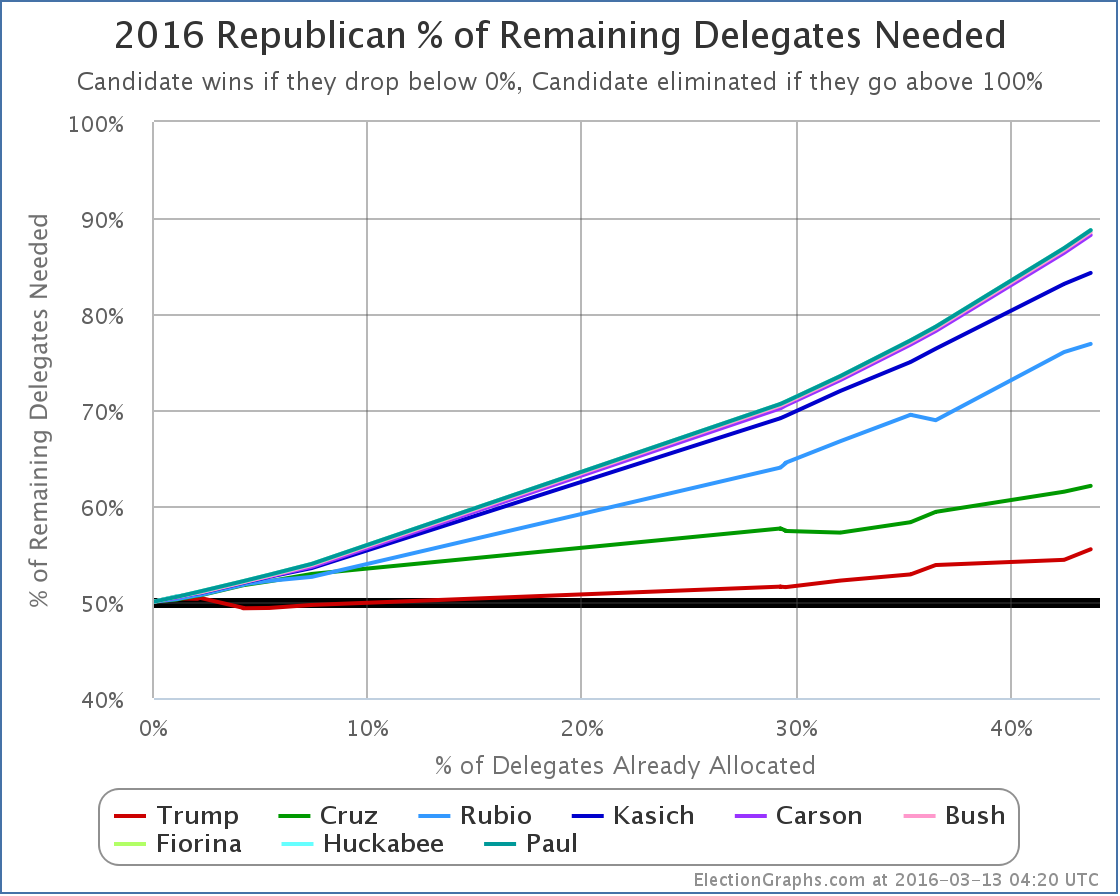
Trump now needs 55.49% of the remaining delegates to win outright. This number is getting high. And the gap between what Trump has done so far (42.96% of delegates) is getting larger. Nobody else got what they needed either of course, so everybody’s numbers got worse, not just Trump’s.
Of course, we still have some big winner take all and winner take most states coming up, so time to refresh the poll based predictions for Tuesday and see what they look like now. As usual, using RCP poll averages and delegate distribution rules from Green Papers.
Florida – 99 delegates – March 15th:
- Poll averages: Trump 41.4%, Rubio 23.3%, Cruz 19.7%, Kasich 9.6%
- Delegate estimate: Trump 99
North Carolina – 72 delegates – March 15th:
- Poll averages: Trump 35.6%, Cruz 23.8%, Rubio 13.0%, Kasich 10.4%
- Delegate estimate: Trump 31, Cruz 21, Rubio 11, Kasich 9
Illinois – 69 delegates – March 15th:
- Poll averages: Trump 34.3%, Cruz 25.3%, Kasich 18.3%, Rubio 14.8%
- Delegate estimate: Trump 35, Cruz 15, Kasich 11, Rubio 8
Ohio – 66 delegates – March 15th:
- Poll averages: Kasich 35.3%, Trump 33.3%, Cruz 20.0%, Rubio 5.8%
- Delegate estimate: Kasich 66
Missouri – 52 delegates – March 15th:
- Using only recent poll: Trump 36.0%, Cruz 29.0%, Rubio 9.0%, Kasich 8.0%
- Delegate estimate: Trump 52
Northern Marianas – 9 delegates – March 15th:
- No polls, using national avg: Trump 36.0%, Cruz 21.8%, Rubio 18.0%, Kasich 12.0%
- Delegate estimate: Trump 9
The main difference from the estimate a few days ago is that now Kasich is ahead in Ohio, and wins the 66 delegates there. This makes a big difference.
Adding these up:
Trump +226, Kasich +86, Cruz +36, Rubio +19
Trump would get 61.6% of the delegates on Tuesday. Which even without Ohio would be above the 55.49% he needs to be tracking toward a clean win.
The new totals would be:
Trump 690, Cruz 408, Rubio 185, Kasich 149, Others 15
Trump would have 47.7% of the delegates. Still not a majority.
When you do all the math at the end of all that, Trump would need 53.37% of the remaining delegates to cleanly win a majority of the delegates. That would still be a substantial improvement from what he had been doing so far.
But there would be more winner take all states coming up. And Cruz, Rubio and Kasich would be so far behind that the scenarios where they would catch up would be extremely far fetched. None of them can win outright. At best they can block Trump. Do all three of them stay in? Do their donors continue to support them in a bid where the only real goal is a contested convention? Can they really keep blocking him from getting a majority of the delegates through a long slog from now until June 7th?
The “Trump wins Florida, but loses Ohio” scenario is the one where it would be premature to say either “Trump will win this outright”, or “Contested Convention”. Instead, we’ll still be hovering between those possibilities, waiting for more states to weigh in.
This might go on awhile.
Finally, as I did with the Democrats earlier, a quick look back, comparing Trump today with Romney in 2012 and McCain in 2008.
First, just looking at the percent of delegates they had as the race progressed:
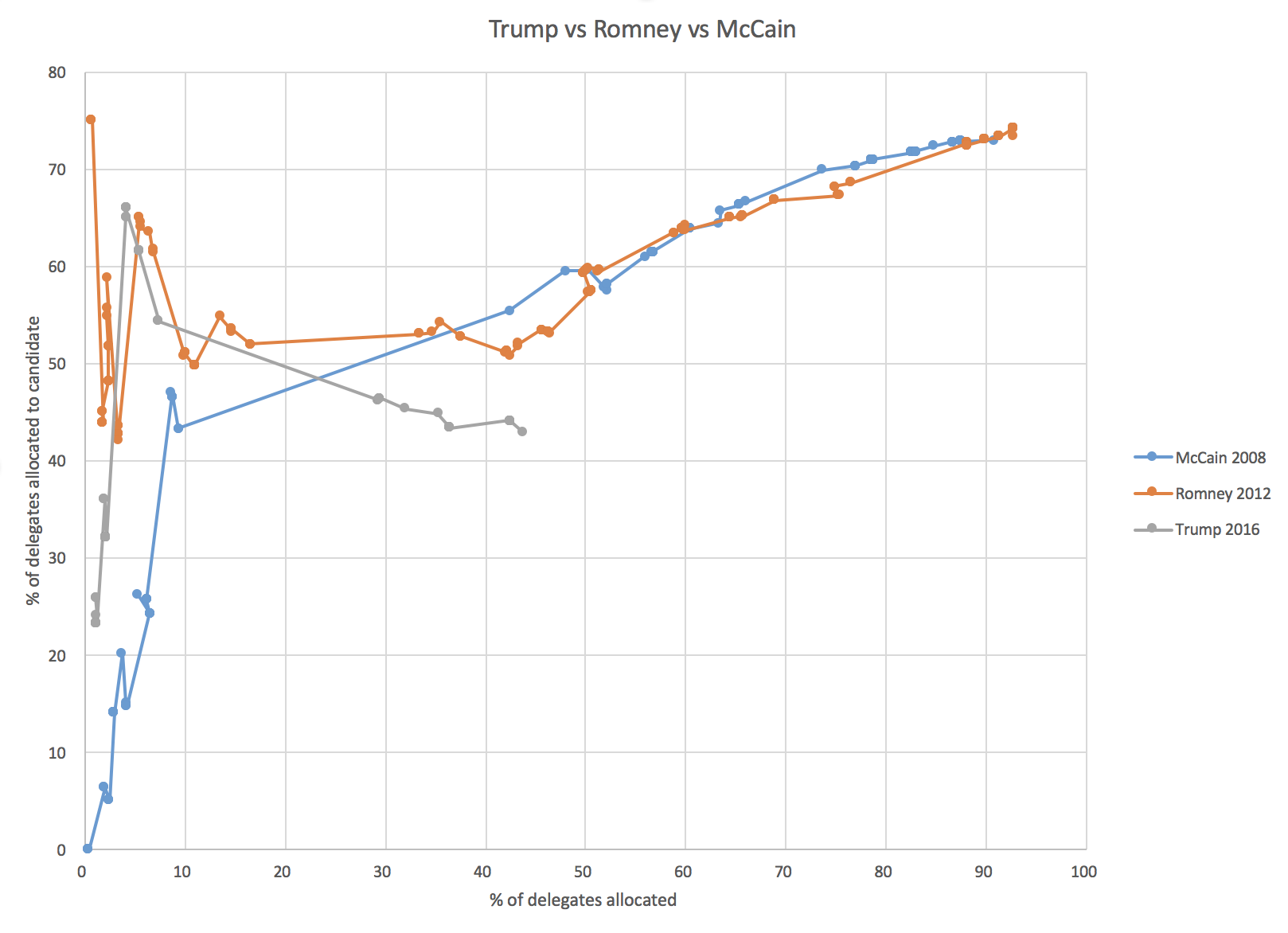
You can see that Trump is behind where either McCain or Romney were at about the same point in the race. But as I’ve said many times, percentages of delegates so far is the wrong way to look at things. Instead, you want to look at the % of the remaining delegates that are needed:
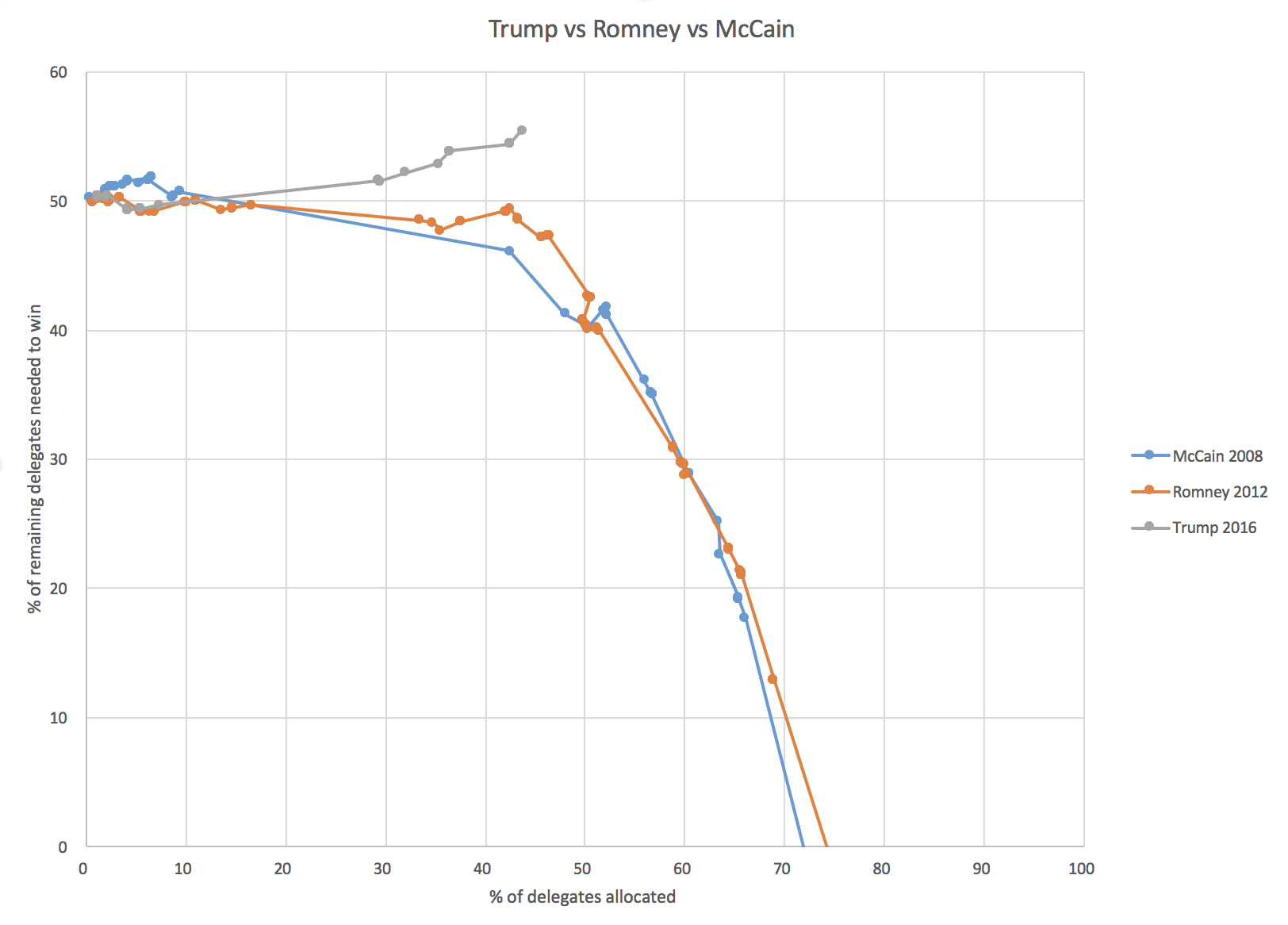
You can see that at this point in the race, both Romney and McCain needed less than 50% of the remaining delegates to win. Trump is way behind that pace. But it was also not until right around now in the races that McCain and Romney really started to pull away. Trump has a harder road here, but with a handful of big winner take all states it is not too late for him to start a downward dive to a flat out win.
But if his line doesn’t manage a full on turn downward, eventually it will curve up, and we’ll end up at the contested convention.
Ohio is close. We will have to wait until Tuesday to see how this thing is going…
Note: This post is an update based on the data on ElectionGraphs.com. Election Graphs tracks both a poll based estimate of the Electoral College and a numbers based look at the Delegate Races. All of the charts and graphs seen in this post are from that site. Additional graphs, charts and raw data can be found there. All charts above are clickable to go to the current version of the detail page the chart is from, which may contain more up to date information than the snapshots on this page, which were current as of the time of this post. Follow @ElectionGraphs on Twitter or like Election Graphs on Facebook to see announcements of updates or to join the conversation. For those interested in individual general election poll updates, follow @ElecCollPolls on Twitter for all the polls as they are added.
[Edit 22:17 UTC to add sentence about other candidate’s numbers getting worse, not just Trump’s.]
[Edit 22:32 UTC to add link to the post on the Democrats.]
|
|
















